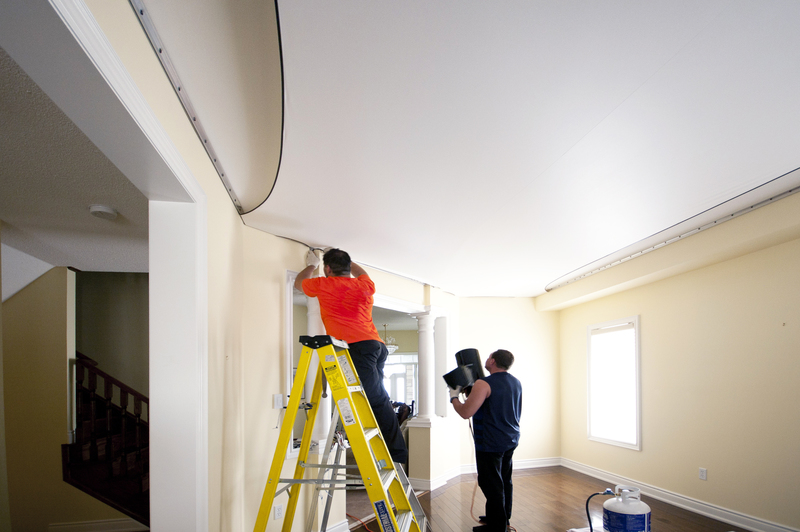The first step you need to do on how to remove mildew from ceiling is to protect yourself from mildew exposure. You get to learn plenty about fungi in this article, from how to identify them and how to prevent them from growing.
Hence, be sure to read this article on mildew removal until the end!

How Does Mildew Grow On Ceilings?
Mildew grows on ceilings mainly due to moisture. Often, your roof suffers from weather damages, and they’re not maintained as it should be.
Most homeowners do not have time to check their roofs for possible issues or damage regularly. This lack of maintenance leads to problems with your roof, which leads to ceiling leaks.
These ceiling leaks would then attract mildew and may even lead to mold growth.
As you know, moisture is the last criterion to be met before mildew or mold grows on a surface. Mildew spores in the air; just wait for the right time when your house suffers from leaks or other forms of water damage, then settle on that area.
How To Identify Mildew On Ceilings?
There are several ways to identify mildew. Some professionals check for the moisture level on the ceiling if the mildew growth is not visible.
If the mildew growth is visible, they tend to take a lighter color than mold. They’re generally white or light yellow, whereas mold tends to be darker (e.g. dark blue, greenish-black, or black).
Moreover, you can see that the texture of mildew is either powdery or downy in contrast to mold’s slimy or fuzzy. Despite this, we do not advise you to touch the mildew growth because you may develop allergic reactions.
Another way of identifying mildew growth is when you notice a distinct earthy smell from your ceiling or walls. Since ceiling leaks also affect walls, mildew may also develop on the walls.
If you see discoloration due to water damage, then it is likely that mildew has grown on the ceiling.
Is Mildew Dangerous?
Mildew is less harmful than mold. However, you can still end up with allergic reactions when you’re exposed to mildew spores.
Moreover, mildew does not penetrate the surface it grows on as mold does. However, it can attract mold.
You may be tasked with mold removal on top of mildew removal and water damage repairs in such circumstances. Hence, mildew may still be considered a threat in your household despite its mild.
Removing Mildew From Ceiling
When it comes to removing mildew, the first thing you have to do is prevent water damage. Here is an article on how to patch a water damaged ceiling as a part of your mildew removal process.
Moreover, before you get rid of mildew on your ceiling, you must put on protective gear. Don goggles to protect your eyes, a pair of gloves, and wear a long-sleeved shirt to prevent prolonged mildew exposure.
Step #1. Make a mildew-killing solution
You can use white vinegar or hydrogen peroxide as mildew-killing solutions, or you can use CLR Mold and Mildew Remover. If you wish to use the commercial product, here is an article talking about where to buy CLR Mold and Mildew remover.
Get a clean and empty spray bottle, then put a diluted white vinegar or hydrogen peroxide in the spray. Spritz the solution on the affected areas of the ceiling, then leave the mixture there for an hour.
Step #2. Rinse the solution
After an hour, rinse off the solution using a showerhead if you’re in the bathroom. If not, use another spray bottle filled with water to remove the mixture from the ceiling.
After rinsing, use a soft brush to remove the mildew that was not rinsed off from the ceiling. Since vinegar has killed the root of the fungi, you only need to remove the leftover.
Step #3. Remove stains
For stubborn stains, mix borax and water in a 1:16 ratio. Spray this borax mixture on the mildew-contaminated parts, then leave it to dry.
After that, brush the area and rinse. Repeat this step until you get rid of the stubborn stains on your ceiling.
Ways To Prevent Mildew Growth
The best way to prevent mildew growth is to stop water damage from happening. To avoid water damage, you have to regularly check your pipes or roof for deterioration.
If there is damage to your roof, make sure to attend to it as soon as possible. Replace the missing shingles and fix the seals.
Make sure to clean your gutter at least twice a year, too.
Another way to prevent mildew growth is to clean your house regularly. Keep it free from dust so that mildew would not have a food source.
Lastly, maintain your home’s humidity and moisture levels to prevent mildew growth.
Conclusion
We’ve told you how to remove mildew from the ceiling; it’s now your job to maintain it and keep it mildew-free. Moreover, we hope you prevent fungi from growing and avoid water damage in your household.
